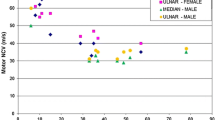Summary
Davidenkow's syndrome has been defined as a hereditary disorder characterized by proximal muscle weakness and wasting in the upper limbs with distal weakness in the lower, and associated with distal sensory loss in all four limbs. It has been assumed to be genetically distinct. A family is described in which the index case displayed these features. Motor nerve conduction velocity was substantially reduced. Another member displayed distal motor and sensory involvement in both upper and lower limbs and thus conformed to the clinical pattern of the hypertrophic form of Charcot-Marie-Tooth disease (hereditary motor and sensory neuropathy type I). A third member was somewhat intermediate, with generalized upper limb and distal lower limb weakness. It is concluded that Davidenkow's syndrome is not genetically distinct and that it may occur as a phenotypic manifestation of type I hereditary motor and sensory neuropathy.
Zusammenfassung
Davidenkow's Syndrom wird als eine Erbkrankheit definiert, welche charakterisiert ist durch eine proximale Muskelschwäche und zunehmende motorische Behinderung der oberen Extremitäten mit distaler Schwäche der unteren, zugleich mit distalen Sensibilitätsstörungen aller vier Gliedmaßen. Es wurde angenommen, daß es sich genetisch um eine wohldefinierte eigene Erkrankung handelt. Es wird eine Familie beschrieben, in welcher der Propositus die oben erwähnten Merkmale aufwies. Die motorische Erregungsleitungsgeschwindigkeit war wesentlich verlangsamt. Ein anderes Glied der Sippe zeigte einen motorischen und sensiblen Befall aller vier Extremitäten und entsprach klinisch der hypertrophischen Form der Charcot-Marie-Toothschen Krankheit (hereditäre motorische und sensorische Neuropathie von Typ I). Ein drittes Glied der Sippe nahm eine intermediäre Stellung ein mit generalisierter Schwäche der oberen Extremitäten und einer distalen Schwäche der unteren. Es wird deshalb gefolgert, daß Davidenkow's Syndrom kein genetisch einheitliches Krankheitsbild ist und daß es als phänotypische Manifestation einer hereditären motorischen und sensorischen Neuropathie vom Typ I auftreten kann.
Similar content being viewed by others
References
Brust JCM, Lovelace RE, Devi S (1978) Clinical and electrodiagnostic features of Charcot-Marie-Tooth syndrome. Acta Neurol Scand 58: Supplement 68:1–142
Davidenkow S (1972) Über die neurotische Muskelatrophie Charcot-Marie. Klinisch-genetische Studien. Z ges Neurol Psychiat 107:259–320
Davidenkow S (1939) Scapuloperoneal amyotrophy. Arch Neurol Psychiat (Chic) 41:694–701
Dyck PJ, Lambert EH (1968) Lower motor and primary sensory neuron diseases with peroneal muscular atrophy. I. Neurologic, genetic and electrophysiologic findings in hereditary polyneuropathy. Arch Neurol (Chic) 18:603–618
Dyck PJ, Lambert EH (1968) Lower motor and primary sensory neuron diseases with peroneal muscular atrophy. II. Neurologic, genetic and electrophysiologic findings in various neuronal degenerations. Arch Neurol (Chic) 18:619–625
Harding AE, Thomas PK (1980) The clinical features of hereditary motor and sensory neuropathy (types I and II). Brain 103:259–280
Kaeser HE (1965) Scapuloperoneal muscular atrophy. Brain 88:407–418
Meadows JC, Marsden, CD (1969) Scapuloperoneal amyotrophy. Arch Neurol (Chic) 20:9–12
Ricker K, Mertens HG, Schimrigk K (1968) The neurogenic scapulo-peroneal syndrome. Eur Neurol 1:257–274
Schwartz MS, Swash M (1975) Scapulo-peroneal atrophy with sensory involvement: Davidenkow's syndrome. J Neurol Neurosurg Psychiat 38:1063–1067
Serratrice G, Pellissier JF, Cremieux G, Baret J, Gastaut JL, Schiano A, Pouget J (1979) Scapuloperoneal myopathies, myelopathies and neuropathies. In: Serratrice G, Roux H (eds) Peroneal atrophies and related disorders. Masson, USA, pp 233–252
Serratrice G, Roux H, Aquaron R, Gambarelli D, Baret J (1969) Myopathies scapulopéronières. (A propos de 14 observations dont 8 avec atteinte faciale.) Sem Hôp Pairs 45:2678–2683
Thomas PK, Calne DB, Elliott CF (1972) X-linked scapuloperoneal syndrome. J Neurol Neurosurg Psychiat 35:208–215
Thomas PK, Calne DB, Stewart G (1974) Hereditary motor and sensory polyneuropathy (peroneal muscular atrophy). Ann Hum Genet 38:111–153
Tsukagoshi H, Takasu T, Yoshida M, Toyokura Y (1969) A family with scapuloperoneal muscular atrophy. Clin Neurol (Tokyo) 9:511–517
Author information
Authors and Affiliations
Rights and permissions
About this article
Cite this article
Harding, A.E., Thomas, P.K. Distal and scapuloperoneal distributions of muscle involvement occurring within a family with type I hereditary motor and sensory neuropathy. J. Neurol. 224, 17–23 (1980). https://doi.org/10.1007/BF00313203
Received:
Issue Date:
DOI: https://doi.org/10.1007/BF00313203




